#water sports propulsion
Explore tagged Tumblr posts
Text
#Mast & Power Assembly#WAYDOO#propulsion system#6000W motor#aluminum alloy#65cm#84cm#brushless motor#WAYDOO mast assembly#6000W brushless motor#aviation-grade aluminum mast#water sports propulsion#durable mast unit
0 notes
Text
Biology of Inkfish - Splatting
“Splatting” is a severe state that all inklings can end up in due to major loss of ink. While inkfish in either of their forms can be splatted, this most often occurs in swim form or minutes within having been in swim form previously. During transformation into swim form, the skin lets more ink through, which makes the introduction of foreign liquids extremely non-ideal. During splatting, enough foreign liquid enters the system for the ink system to forcibly eject most, if not all, of the ink in the body as a response to unidentified ink. This happens when the ink hearts* all contract in unison to try to replace unfamiliar substances in the ink stream, or as an extreme response to a threat. Ink is sprayed out from all ink ducts in an explosive manner, which may deter an attacking predator and clear out the ink system, but which also leaves the inkfish stranded on the ground.
*The ink hearts are minor organs situated at different points of the ink vein network, and are responsible for cycling and ejecting ink.
Inklings have extremely stretchy skin, as well as specialized muscle structures that keep their shape and strengthen when ink is coursed through them. Thus, when ink flow is redirected or reduced, these muscles shrink and flatten - when ink is removed from the muscles and the body, smaller inkfish can lose more than 50% of their total body weight. In inkfish, this adaptation is useful as the shape of the body and even the consistency can be greatly altered. However, it comes with the downside that an inkling that has lost most or all of its ink will struggle to move quickly and may be unable to escape from predators until enough ink is recovered, which may take minutes without outside help. To adapt, inkfish have also improvised a way to utilize their significantly lighter bodies and use the propulsion organ inside their heads to use the remaining bits of their ink to launch into the air and fill the organ with air to attempt to float to safety.
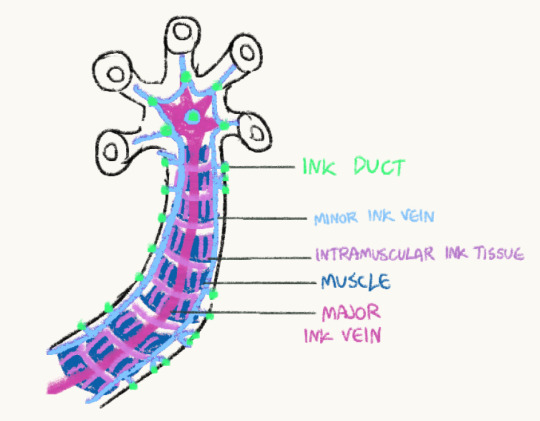
[A diagram of an inkling's basic ink layers. The major ink veins run across the body, pumping ink from the ink sac and splitting into hundreds of minor ink veins. Minor ink veins transport ink to the ink-holding tissue within muscles as well as the ink ducts, which bleed out ink through the skin. When these ink ducts are open, the flow of ink between the skin and the body is high.]
Splatting is a key element in some aspects of inkling culture, like Turf Wars and other extreme sports. In Turf Wars, enemy ink of another consistency will cause a rejection of all the circulating ink in an inkfish’s body in large amounts. A more controlled form of splatting can also occur as a defensive mechanism from extreme agitation, and is used in some attacks, such as the Kraken spin and especially Splashdown. These splatters are typically sustainable for users during Special states due to the high amount of ink that is being produced. Being in contact with other people's ink is known to boost ink production as a whole.
Splatting looks very violent to other species, but it is mostly harmless to inkfish with normal bodily functions. Inkfish in a safe environment will regenerate from splatting on their own given enough time to regain their ink, and splatting can be immediately treated if replacement ink is introduced. Splatted inkfish will absorb ink from their environment and replenish their bodies in a matter of seconds. The only common situation in which splatting is irrecoverable is in situations where the body is engulfed in water, in which case water being absorbed through the skin will flush the ink from the body and prevent recovery. This makes inkfish ill-fitted for being in the water, though they can use their air sacs to float on top of the surface, and attempt to swim or jet propel themselves onto land.
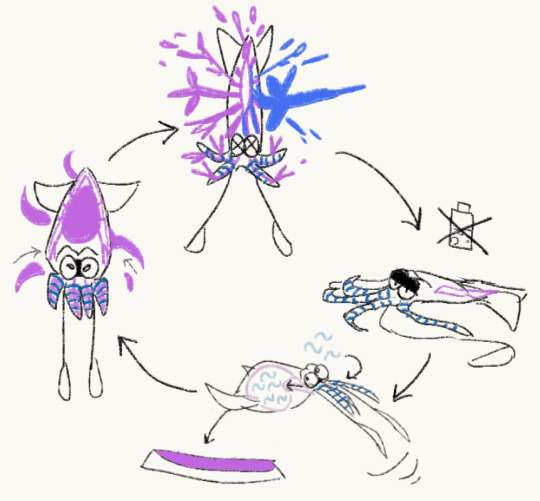
[An example showing the processes of the body when inkfish are splatted. The body rejects ink of the wrong color by forcefully ejecting all the ink in the ink sac and system, leaving the body in a low-ink "splatted" state. Inkfish are able to draw air into their mantles to utilize their reduced body weight and jet propulsion abilities to fly to an area where ink can be absorbed back into the body, which is a fast process.]
44 notes
·
View notes
Text

TF2 x ATLA AU :3


Lore, close ups, and doodles underneath !
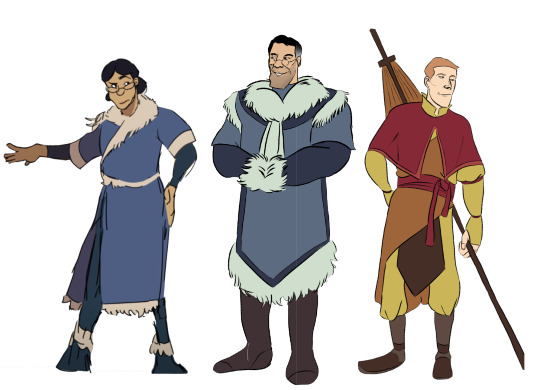
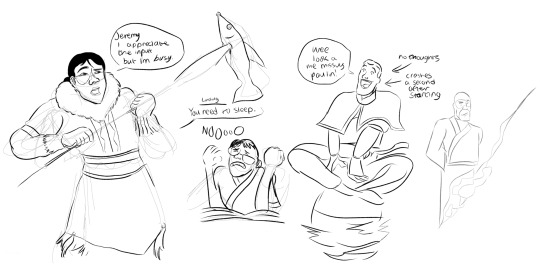
Scout, Pauling, and Ludwig are the main three- scout, who’s an (admittedly shitty) airbender but not the avatar, who ran away after his father left. Once spotted by fire nation soldiers, he is presumed to be the avatar- and scout basks in the glory of his false identity. Pauling- a studious, too serious for her own good, non-bender, who’s Medic’s student. She’s of the southern water tribe, treating medic like her paternal figure after the disappearance of her aunt. Medic is (unbeknownst to pauling and scout) a blood bender who was exiled for his practices. He doesn’t seem to care for anyone or anything, also being very jovial and cheery.
All Pauling and Scout know is that Ludwig was exiled from the northern water tribe then fled to the south for an undisclosed reason. Pauling never bothered to pry and the Scout was too intimidated to. Here the avatar cycle has indeed been broken. It’s up to a group of nine ragtag men and one mousy girl to defeat Gray Mann.
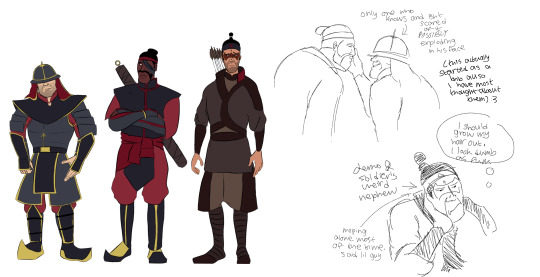
And the main three villains are soldier, demo, and sniper who're all fire nation folk. Sort of the team rocket; never truly competent enough to cause real damage, that or their hearts truly aren’t in it.
Soldier's a fire bender who specializes in jet propulsion and was kicked out of the army. He thinks if he steals back the avatar, they'll let him back in. A weapon since childhood, once a bully, always a bully, or so he’s heard.Character arc being the realization the fire nation army isn't worth fighting for. Surprisingly, he is very good with spirits, opposite to his best friend, Tavish, who despises them.
Demo’s just trying to impress his mum and be a good friend to the Soldier. People pleasing tendencies, that's his character arc. He's supposedly a non bender who's mighty good with swords; but underneath his inconspicuous-ish eye patch holds a combustion bending tattoo. Only Jane knows this. Well-versed in calligraphy.
Sniper is a 26 year old yuyan archer who was discharged for failing a mission while he was young. He joined the other two with the same goal as the Soldier. His yuyan archer tattoo still remains. He's a non bender with excellent aim, who grew up on the rural outskirts of the fire nation. His character arc is something about not adhering to expectations and learning who he's fighting for; a combination of the demoman and the soldier’s lessons.
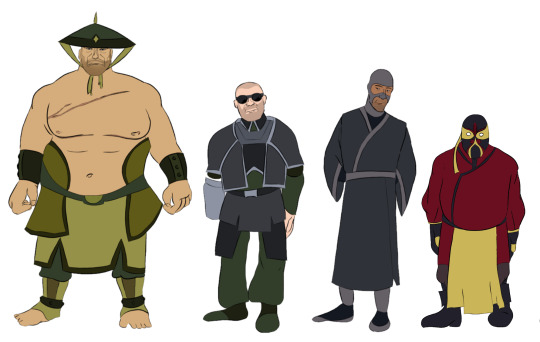
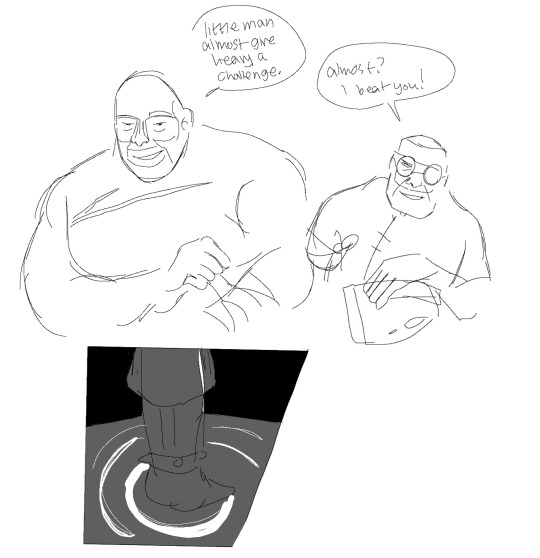
Spy's a crusty airbender constantly sporting a mask to hide his tattoos, and knife. Nobody has a clue where he's from and he takes orders from whoever pays him best. His airbending tricks are so subtle, the public believes him to be a crafty nonbender. Usually said tricks are only invisibility and voice alteration. While not assassinating political figures he traverses the spirit world looking for his wife, a fellow air nomad, avoiding physical aging in brief sprints of time. He returns on a well paid mission to kill the “avatar,” which was presumably the scout. Little does he know, that weird whiteboy is just some lame airbender. Who’s also his son. His bad.
Engineers the metalbender; an art perfected by his ancestors and passed down in whispers to him. I haven't developed him much. He teaches the Scout what he knows while obscuring information on how he got that metal arm. Him and the Pyro have a shared love of blacksmithing. From an explosion, he thinks..
Pyro's a spirit probably. Nobody knows what he is. Where he’s from? Pyro. What’s his gender? Pyro. Guy who sets things on fire. Presumably human judging by his questionable use of what looks to be fire bending. And also the Spy's companion! They met in the spirit world. He and the Soldier form a close bond quite quickly thanks to their good graces with spirits (to Tavish’s immense dismay).
Heavy's an earth bender who continues to win in underground fights. Residing in ba sing se with his three sisters and elderly mother, scout pauling and medic meet him in an earth bender championship. Despite what his appearance suggests, his patience is unmatched, which is his greatest strength. He has near -perfect seismic sense. He and the Medic get on quite well, and after the fire lord has been struck down, form a duo in the ring, earning even more won championships.
#This was stupid and self indulgent. But if you . Maybe wanna talk to me about it. GRAHH#I lobe them :(#tf2#art#team fortress 2#tf2 scout#tf2 soldier#tf2 pyro#tf2 demoman#tf2 heavy#tf2 engineer#tf2 medic#tf2 sniper#tf2 spy#tf2 au#atla#avatar the last airbender#heavymedic#boots n bombs#//blood#tw blood#some of these doodles look horrible. But whatever. it’s fine I got excited about an idea and spent 5 hours on the full team ref#Quotidianish#Atla au
392 notes
·
View notes
Text
Humanity in 100 years
In the year 2124, the world has transformed into a space-faring society, and the military academies have evolved to train the next generation of space cadets. Here's a detailed look at what such an academy might be like:
Academy Overview: The Stellar Command Academy (SCA)
Location: The Stellar Command Academy is located on a space station orbiting Earth, known as the "Orbital Citadel." This station is equipped with advanced gravity simulation technology, allowing cadets to train in environments mimicking various planetary conditions.
Mission: The SCA's primary mission is to prepare cadets for roles in space exploration, defense, and diplomacy. The academy emphasizes not only military tactics but also scientific research, interstellar relations, and advanced technological skills.
Curriculum and Training
Core Courses:
Astro-Navigation: Cadets learn to navigate the vastness of space using advanced star charts and quantum navigation systems.
Exo-Biology: Understanding alien ecosystems and life forms is crucial for missions to distant planets.
Quantum Mechanics and Engineering: Cadets are trained in the latest technologies, including quantum computing and propulsion systems.
Interstellar Diplomacy: Training in negotiation and cultural understanding to manage relations with potential alien civilizations.
Physical Training:
Zero-G Combat: Cadets practice combat techniques in zero-gravity environments, using specialized suits and weapons.
Planetary Survival: Training in survival skills on various planetary terrains, from desert worlds to icy moons.
Spacecraft Piloting: Cadets learn to operate a variety of spacecraft, from small fighters to large exploratory vessels.
Simulations and Missions:
Virtual Reality Scenarios: Cadets undergo intense virtual reality training, simulating everything from space battles to diplomatic encounters with alien species.
Real-World Missions: Advanced cadets participate in real missions, such as asteroid mining operations, rescue missions, and exploratory expeditions to the outer planets.
Technology and Equipment
Suits and Gear:
Adaptive Combat Suits: These suits adjust to different planetary environments and can enhance the wearer's strength and endurance.
Neural Interfaces: Cadets use neural interfaces to control spacecraft and drones, allowing for faster reaction times and more precise control.
Weapons and Defense:
Energy Weapons: Advanced plasma and laser weapons are standard issue, designed for use in various atmospheric conditions.
Shielding Technology: Personal and spacecraft shielding systems protect against hostile environments and enemy attacks.
Transportation:
Fighter Jets and Shuttles: Cadets train with a fleet of high-speed spacecraft capable of atmospheric and space flight.
Warp-capable Vessels: For longer missions, cadets learn to operate ships equipped with experimental warp drives.
Life at the Academy
Dormitories and Living Quarters:
Cadets live in modular dormitories that can be reconfigured to simulate different living conditions, preparing them for life on various space stations and planetary bases.
Advanced life support systems ensure a comfortable living environment, recycling air and water efficiently.
Social and Recreational Activities:
Holodecks: Recreational facilities include holodecks where cadets can participate in virtual sports, cultural events, and relaxation activities.
Interstellar Sports: Cadets compete in sports adapted for zero-gravity environments, such as zero-g soccer and space rugby.
Cultural Integration:
The academy fosters a diverse and inclusive environment, with cadets from various planets and backgrounds. Cultural exchange programs are common, promoting understanding and cooperation among future space leaders.
Graduation and Career Paths
Graduation Ceremony:
The graduation ceremony is held in a grand hall on the Orbital Citadel, with dignitaries from Earth and other planets in attendance.
Cadets receive their commissions and are assigned to various branches of the space military, such as the Space Fleet, the Planetary Defense Force, or the Interstellar Diplomatic Corps.
Career Opportunities:
Space Fleet: Cadets can serve on exploratory missions, defend against potential threats, and conduct scientific research.
Planetary Defense Force: Graduates may be stationed on planets and moons, protecting settlements and conducting security operations.
Interstellar Diplomatic Corps: Cadets with a focus on diplomacy can represent Earth in negotiations with other civilizations, fostering peace and cooperation.
Challenges and Future Prospects
Technological Advancements:
The academy must constantly adapt to new technologies, requiring continuous updates to its curriculum and facilities.
Research and development are ongoing, with cadets often involved in testing and refining new systems.
Interstellar Relations:
As humanity encounters more alien species, the academy plays a crucial role in preparing cadets for the complexities of interstellar politics and potential conflicts.
Environmental and Ethical Considerations:
Cadets are trained to respect and preserve the environments of other planets, adhering to strict ethical guidelines.
Ethical dilemmas, such as the use of advanced AI in warfare and the rights of sentient beings, are part of the curriculum.
In this future, the Stellar Command Academy stands as a beacon of human progress, training the next generation to explore, defend, and connect with the vast universe beyond Earth.
2 notes
·
View notes
Text
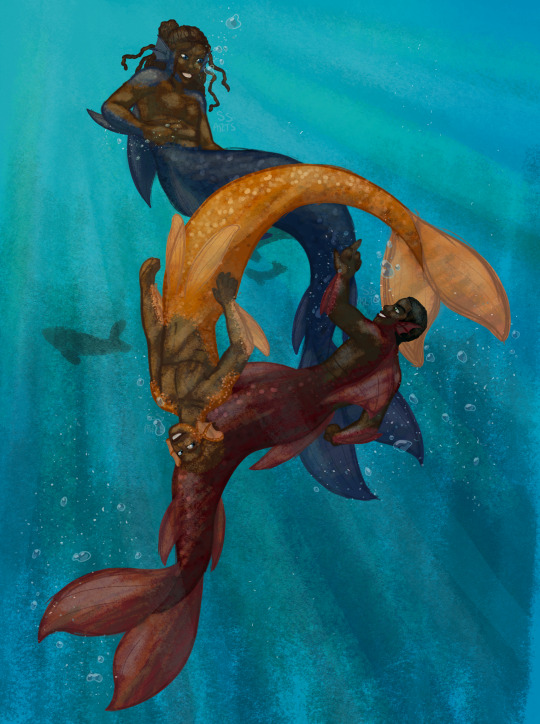

HAPPY BIRTHDAY @cxlesstial ur old now lol but enjoy some updated mermaid song art🤪 more information about why I designed them the way I did below the cut!
Raph and Leo are modeled after open ocean sports fish like tuna and marlins. They’ve got sharp, aerodynamic fins to help them slice through the water, including dorsal fins to help prevent them from rolling over as they swim, pectoral fins (on the arms; arms themselves are kinda like pectoral fins on mermaids) to help them steer, and adipose fins on the hips and lower tail to help with additional stability and to sense the flow of water currents.
Mikey and April aren’t modeled after any specific fish, but I had reef fish in mind as I designed them. They’re the most brightly colored of all of them, and they’re designed for agility with pectoral fins for steering, pelvic fins for abrupt stops and turns, and no fins like the dorsal fin which would prevent them from barrel rolling if they wanted to.
Casey and Donnie are modeled after whales. The most obvious is that they’re covered in skin, not scales, and their fins are cartilage rather than suspended between rays (thin bones) like with the other mermaids. They’ve got large caudal fins for propulsion, dorsal fins for stability, and pectoral fins on their arms for steering. They were designed not for speed or agility, but stamina; they can swim for long distances over open ocean. Their coloring is also inspired by whales; darker on the top and lighter on the bottom is a form of camouflage. Casey in particular looks like an orca.
#my art#digital art#teenage mutant ninja turtles#tmnt 2012#donatello#Raphael#Leonardo#Michelangelo#Casey jones#april o’neil#fan art
28 notes
·
View notes
Text
Rotax Engines: Engineering Power, Precision, and Performance
Introduction
In the world of high-performance engines, few names carry the weight and respect that Rotax does. For decades, Rotax has stood as a symbol of reliability, innovation, and engineering excellence. Whether powering aircraft, snowmobiles, motorcycles, or go-karts, Rotax engines have proven themselves across diverse terrains and industries. This article explores the legacy, innovation, and ongoing impact of Rotax in the global market.

The History and Heritage of Rotax
Founded in 1920 in Dresden, Germany, and later relocating to Austria, Rotax has evolved from a modest manufacturer into a global engineering powerhouse. Now a part of Bombardier Recreational Products (BRP), Rotax is synonymous with advanced engine technology. Its success stems from a relentless focus on research and development, enabling it to produce engines that meet the demands of both recreational and professional users.
Rotax's early reputation was built on reliable engines for motorcycles and scooters. As the company expanded, it diversified into new industries—most notably aviation and powersports—where high performance, lightweight design, and dependability are non-negotiable.
Innovation at the Core
Rotax engines are known for their advanced engineering, fuel efficiency, and lightweight yet powerful performance. One of their most significant innovations is the development of 2-stroke and 4-stroke engine technology optimized for various applications. Whether you're flying a light sport aircraft or tearing up the racetrack in a go-kart, Rotax engines deliver unmatched throttle response and smooth operation.
In aviation, Rotax has made waves with the 912 and 915 series, offering dependable, fuel-efficient engines for light aircraft and ultralights. Their reputation in aviation is not just built on performance, but also on safety, reliability, and ease of maintenance.
For powersports, engines like the Rotax 850 E-TEC have set new benchmarks in snowmobile performance. Similarly, their engines power vehicles from BRP brands like Ski-Doo, Sea-Doo, and Can-Am, ensuring that thrill-seekers experience top-tier reliability on land, snow, and water.
Applications Across Industries
Rotax engines serve multiple sectors, making them one of the most versatile manufacturers in the world:
Aviation: Rotax is the leading engine choice for light sport and experimental aircraft worldwide.
Motorcycles & Scooters: From classic road bikes to modern off-road models, Rotax engines offer both performance and fuel efficiency.
Powersports: Snowmobiles, jet skis, and ATVs powered by Rotax deliver adventure and reliability in extreme conditions.
Karting: Rotax MAX engines dominate the world of professional karting, known for their consistency and ease of maintenance.
This cross-industry application demonstrates Rotax’s ability to innovate to meet the diverse needs of users, from hobbyists to professionals.
Sustainability and the Future
Rotax has also placed a strong emphasis on sustainability, developing cleaner, more efficient engines that reduce emissions without sacrificing performance. Their focus on fuel economy and the introduction of more eco-friendly technologies ensures they are well-positioned for a future where environmental impact matters as much as power.
The company continues to invest heavily in electric and hybrid propulsion systems, signaling its readiness to evolve with the demands of a changing world. This forward-thinking approach ensures that Rotax remains relevant and respected, even as the engine industry moves into a new era.
Conclusion
Rotax is more than just an engine manufacturer—it's a brand built on trust, technology, and transformative performance. With a legacy of over a century, Rotax continues to redefine what’s possible in engine design, powering machines that thrill, inspire, and perform. Whether in the sky, on the track, or across rugged terrain, Rotax engines are a testament to what happens when engineering meets excellence.
1 note
·
View note
Text
What It’s Like to Ride a Hybrid Water Taxi for the First Time
There’s something inherently magical about traveling by water. Whether it’s the rhythmic sway of the current or the uninterrupted views of the coastline, water travel has always had its charm. But my recent experience riding a hybrid water taxi for the first time took that charm to a whole new level—where sustainability meets sleek innovation.
First Impressions: Quiet and Smooth
Unlike traditional boats that roar to life with a blast of fumes and noise, this hybrid water taxi gently glided away from the dock almost silently. I found myself questioning whether we had even started moving. The electric propulsion system made the ride feel smooth, stable, and far quieter than I expected—perfect for enjoying a peaceful commute or a sightseeing cruise.
A Blend of Comfort and Technology
Stepping aboard, I noticed the clean, modern design. Plush seating, panoramic windows, and an open-air deck area made for a pleasant ride. Onboard screens displayed route information, estimated arrival times, and even real-time emissions savings. The staff were happy to explain how the hybrid system worked—switching between electric and fuel modes as needed to maximize efficiency.
The Speed Surprise
Don’t let the word “hybrid” fool you into thinking these boats are slow. Fast Hybrid Water Taxis are engineered to deliver on both performance and environmental friendliness. When the boat shifted to full power, we picked up speed quickly without losing the quiet, clean feel of the ride. It was like merging the best parts of a ferry and a sports car, gliding over the water at impressive speeds.
Sustainable and Scenic
What stood out most was the feeling of being part of something future-forward. With cities becoming more eco-conscious, these taxis are reducing maritime emissions and noise pollution. As we cruised past city skylines and waterfronts, it felt good knowing that this form of transport wasn’t just enjoyable—it was responsible.
Would I Do It Again?
Absolutely. Whether you're commuting across a harbor or just looking to enjoy a unique tour of your city’s waterfront, Fast Hybrid Water Taxis offer an experience that’s clean, modern, and surprisingly fun. It’s the kind of ride that makes you wonder why we waited so long to switch gears—literally and figuratively.
0 notes
Text
Leisure Power Boat Market : Growth Key Drivers Shaping the Future of Recreational Boating
The leisure power boat market has experienced substantial growth in recent years, driven by several factors that continue to shape the industry's trajectory. From technological advancements to changing consumer preferences, various drivers are contributing to the market's expansion.

Technological Advancements
One of the foremost drivers of growth in the leisure power boat market is technological innovation. Modern power boats are equipped with cutting-edge features, such as advanced navigation systems, electric propulsion technologies, and improved fuel efficiency. These technological improvements not only enhance the overall performance of leisure boats but also attract eco-conscious consumers who are keen to reduce their environmental impact. Moreover, digitalization and smart technologies such as app-controlled functions, autonomous navigation, and real-time tracking have revolutionized the way boat owners interact with their vessels.
Increasing Disposable Incomes
The rise in disposable income, particularly among consumers in developed and emerging markets, is another significant driver for the leisure power boat industry. As more people attain higher levels of income, discretionary spending on recreational activities like boating becomes more prevalent. High-net-worth individuals and affluent consumers are increasingly investing in luxury yachts and power boats, further contributing to market growth. This surge in spending has also led to a rise in boat ownership and the development of exclusive boating experiences.
Popularity of Water-Based Leisure Activities
The growing popularity of water-based leisure activities such as fishing, water skiing, and recreational cruising is another critical factor driving the demand for leisure power boats. Consumers are increasingly seeking outdoor adventures and recreational activities that offer relaxation, thrill, and socialization. Power boats provide an ideal platform for a range of water sports, and as a result, there has been a notable increase in participation in these activities. This trend is particularly strong in coastal regions and popular vacation destinations where boating is a prevalent pastime.
Growing Marine Tourism
Marine tourism is another factor propelling the growth of the leisure power boat market. As global tourism continues to rise, marine-based tourism destinations are gaining popularity, attracting boat enthusiasts from around the world. The rise in luxury cruise tourism, yacht charters, and private boating holidays has created a thriving market for leisure power boats. Additionally, travel agencies and luxury vacation providers are offering exclusive boating experiences to cater to the demands of affluent travelers, further contributing to market expansion.
Shift Toward Sustainable Boating
Sustainability is a growing trend that is transforming industries worldwide, and the leisure power boat market is no exception. Environmental concerns are prompting manufacturers to innovate and design more eco-friendly boats, such as those powered by electric motors or alternative fuels. With growing awareness of climate change and environmental degradation, consumers are increasingly gravitating toward sustainable boating solutions. The shift toward sustainable power boats is further influenced by stricter regulations regarding emissions and fuel efficiency in various regions.
Advancements in Boat Materials and Design
The use of lightweight and durable materials in boat construction is another key driver in the leisure power boat market. Carbon fiber, fiberglass, and advanced composite materials are being increasingly adopted to enhance the performance, durability, and aesthetics of power boats. These materials reduce weight, improve fuel efficiency, and allow for more efficient manufacturing processes. Additionally, innovative boat designs are appealing to consumers who seek both performance and aesthetic appeal in their leisure vessels.
Government Support and Infrastructure Development
Government initiatives aimed at promoting tourism and leisure activities are also contributing to the growth of the leisure power boat market. Investments in marina infrastructure, boating facilities, and waterfront development projects have made it easier for boaters to access water bodies and enjoy recreational activities. Additionally, many governments are implementing policies to support the development of eco-friendly and sustainable boating practices, aligning with the global push for cleaner oceans and waters.
Conclusion
In conclusion, the leisure power boat market is witnessing substantial growth due to a combination of technological advancements, increasing disposable incomes, rising popularity of water-based leisure activities, and growing marine tourism. The ongoing shift toward sustainability and the development of innovative boat materials and designs are further fueling the market's expansion. As these drivers continue to evolve, the leisure power boat industry is poised for continued innovation and growth in the coming years.
0 notes
Text
Youth Lagoon Live Preview: 5/7, Outset, Chicago

Photo by Tyler T Williams
BY JORDAN MAINZER
Two years ago, Youth Lagoon returned with Heaven Is a Junkyard, Trevor Powers staring at a tumultuous period of his life from the other side. Thankfully, the comeback album--his first in 8 years--opened the floodgates of ideas. Powers found himself searching for an old harmonica that belonged to his grandmother and instead discovered a deluge of home videos, which proved not just creative fodder for his new album Rarely Do I Dream (Fat Possum) but source material. Powers started recording the tapes and ended up sampling them in his new songs, seeped in a distant past that he felt a freedom to rearrange. As a result, Rarely Do I Dream is the most expansive-sounding, genre-averse Youth Lagoon record yet. More impressively, it contains some of Powers' most clever storytelling.

Photo by Tyler T Williams
Throughout Rarely Do I Dream, it isn't so much what videos Powers samples, and the content therein, as much as how he fuses them with the instrumentation. They arrive with gentle piano on "Neighborhood Scene", as he eases us into the album's sonic world. "Gumshoe (Dracula From Arkansas)" is an exercise in contrast--between songwriting and field recording, yes, but also between plucked acoustic and bluesy electric guitar, between brutality and innocence. "We've been up in the tree, climbed down by the water," Powers sings, on the very same song in which he declares, "The summer taught me that life's a baseball bat to the jaw." On "My Beautiful Girl", the home recordings return the record to a sense of reality, rare quiet after the cacophony of "Perfect World". The only song in which Powers truly lets the videos do the talking is on the otherwise instrumental "Home Movies (1989-1993)". Still, it's the sound of tapes ejected and a new one put in that drives the track's cinematic feel.

Photo by Tyler T Williams
That Powers wrote Rarely Do I Dream on guitar instead of piano perhaps helped him further differentiate from the early 2010s Youth Lagoon sound for which he became known. Heaven Is a Junkyard sported tactile loops and handclaps but was subdued. Rarely Do I Dream, on the other hand, combines the epic arrangements of his back catalog with a full palate emphasizing the abstract timbres of synthesizer, drum programming, electric guitar, lap steel, and viola. You can dance to the propulsive, borderline funky drum beat of opener "Neighborhood Scene", or the distorted synth bass of the at-times-grey-hued, other-times-garbled "Speed Freak". Yet, Powers toys with your expectations, bringing even the most skyward club songs back to earth. "Perfect World" starts with blipping arpeggios before being slowed down by its drums and a shoegaze chorus. "Canary"'s tambourine-imbued four-on-the-floor thump, replete with syncopated vocal (or vocal-like) samples, wobbles to the finish line as a rock song, led by Stewart Cole's horns and Gabe Noel's bass.

Photo by Tyler T Williams
Powers has always been an empathetic lyricist above all, especially when illustrating the bleakness surrounding him. But the words on Rarely Do I Dream are more poetic and all-encompassing than ever. I don't recall any previous Youth Lagoon records that featured individual couplets or verses that could make you laugh, ponder, or cry as much as on Rarely Do I Dream. "All the Camels on the rug / A smoker's River Nile," he winks on "Lucy Takes a Picture". "A couple vampires looking strung out," Powers sings on "Canary", a line you initially think is fantastical until he clarifies, "Halloween and homemade alcohol." The user on "Perfect World" shakes "like an extra on opening night," prior to a nerve-wracking drug deal in a stark border town--or is it withdrawal? And then there's "My Beautiful Girl", which paints a scene straight out of a Coen Brothers film, where an addict stores their pills at the bottom of the sandals of "a dollar store, rubber Jesus on the mantle," before Powers delivers the devastating kicker: "Your mama screamed when you thought she couldn't scream more / Your daddy's deaf, so he never heard the screen door." That the violence is presumed rather than detailed makes it powerful.

Photo by Tyler T Williams
Tonight, Youth Lagoon plays Outset. If the minimalism of Powers' older material gave space for him to expand upon his sound live, how will he capture the spirit of a bigger album on stage? In any case, expect to hear a mix of Rarely Do I Dream and his past albums. Vancouver singer-songwriter Kaleah Lee opens. The show is all ages and begins at 6:30 P.M. Tickets still available at time of publication.
youtube
#live picks#youth lagoon#outset#fat possum#kaleah lee#rarely do i dream#tyler t williams#heaven is a junkyard#trevor powers#fat possum records#stewart cole#gabe noel#coen brothers
0 notes
Text
KoozWave electric surfboard opens a new era of waveless surfing
As a leading company in the water entertainment equipment industry, Fitun Technolog officially announced today that its flagship product, KoozWave electric surfboard, has been successfully launched in 37 countries and regions around the world and has become the preferred equipment for water sports enthusiasts and business partners. With strong R&D capabilities and dozens of core patented technologies, KoozWave is redefining the future of surfing.
Waveless surfing, a technological innovation that breaks through natural limitations. Traditional surfing depends on wave conditions, but the KoozWave electric surfboard uses a turbine vector propulsion engine and an AI intelligent balance system, allowing users to enjoy the thrill of extreme surfing in lakes, rivers, and even swimming pools without waiting for waves. Its maximum speed can reach 55 kilometers per hour, which is comparable to the exciting experience of Class 3 waves at sea. It also supports both standing and prone modes to meet the needs of different users.

"Our goal is to make surfing no longer limited by natural conditions," said Fitun Technology CEO. "KoozWave not only lowers the threshold for surfing, but also brings new business opportunities to the global water entertainment industry."
The global market has performed well, and partners have doubled their profits. Since its launch, KoozWave electric surfboards have helped more than 500 water clubs and resorts around the world increase their revenue. For example, after a well-known resort introduced KoozWave, the off-season passenger flow increased by 65%; a dealer Water Sports' annual sales exceeded 1.200 units, and the repurchase rate reached 41%.
User surveys show that 92% of players believe that KoozWave significantly reduces the learning cost of surfing, allowing more people to easily enjoy the fun of water sports.
Sustainable design leads the future of the industry,Fiturn Technology always adheres to the concept of sustainable development. KoozWave is ergonomically designed and uses 97% recyclable materials, which complies with the EU RoHS 2.0 environmental protection standard. Its high-efficiency power system consumes only 1/3 of the energy of traditional gasoline-powered boats within the same cruising range.

Global Dealer Program,To accelerate market expansion, Fitun Technology launched the KoozWave Global Dealer Program, providing: exclusive regional protection to avoid market overlap. High profit returns: factory price is 45% lower than retail price, and annual purchases of 500 units can enjoy more discounts;
Full support for localized marketing materials, AR virtual experience tools and exclusive account manager services.
Individual players who are eager to break through natural limitations → Order now
Seeking business partners in high-growth tracks → Apply for agency
1 note
·
View note
Text
1. Hydra-Class Multipurpose Recreational Pod
Purpose: Recreation, Exploration, Personal Transport
Use Cases: Nexus hangar travel, spacewalks, underwater dives, zero-G parks
Features:
Shape-shifting Hull: Uses memory metal and reflective armor to shift between space-capable, underwater-capable, and pressurized environments.
Single or Dual Occupant: Can hold 1–2 people comfortably; optional neural plug-in for Iron Spine control.
Holo-Recreation Suite: Provides immersive environments (virtual forests, waves, or gravity games) by projecting augmented reality overlays.
Thrusters & Micro-Propulsion: Compact ion thrusters for in-space drifting or quick movement in zero-G; hydrojets for water propulsion.
Docking Spines: Auto-dock to Nexus systems magnetically; also latch onto ships and floating docks.
2. Pelican-Class Atmospheric Entry Shuttle
Purpose: Ship-to-Planet, Planet-to-Ocean, Emergency Evac
Use Cases: Deploying from Nexus or PSV to ground or sea
Features:
Retractable Wings and Airfoils: For smooth gliding through planetary atmospheres and heavy weather.
Buoyant Hull: Floats on water like a lifeboat; deploys underwater drones and opens rear hatch for swimming or diving missions.
Iron Spine Helm: Optional spinal port allows a single pilot to control via reflexive interface.
Crew Size: 4–10 passengers or light cargo; also usable for sporting events or training flights.
3. Tetra-Class Personal Suborbital Skiff
Purpose: High-speed space commute, ship-to-ship taxi
Use Cases: Transferring between fleet vessels, Nexus interior transit
Features:
Ultra-Compact Cockpit: Minimalist design, accommodates one pilot.
Hardlight Canopy: Viewscreen with Iron Spine HUD overlays and AI navigation.
Reflective Skin: Highly defensive against laser and plasma threats.
Hybrid Fusion Drive: Burst acceleration for docking or dogfighting sports.
Custom Mods: Recreational racers often mod these for grav-ball, zero-G jousts, and orbital chase games.
4. Leviathan-Class Amphibious Hovercraft
Purpose: Water-to-Land recreation, Transport over terrain
Use Cases: Operating from planetary base camps, oceanic settlements
Features:
Air-Cushion Undercarriage: Glides across land, sea, or ice using magnetic repulsion or air pressure.
Spinal Sync Cabin: Connects to user’s exo-suit or suit’s spinal plug.
Pleasure Deck Options: Convertible roof with water jets, hammocks, and holo-projection games.
Articulating Skirts: Adjust for terrain, allowing access to beaches, forest floors, and ocean floors.
5. Echo-Class Void Kayak
Purpose: Personal sport craft for void or ocean
Use Cases: Silent movement for exploration, recreation, or stealth recon
Features:
Anti-Grav or Hydrodynamic Hull: Choose environment and switch modes on command.
One-Person Rec Interface: Paddling is optional—AI and spinal sync can navigate with minimal input.
Survival-Grade Armor: Can act as an emergency escape craft; stores rations, water, air, and medical kit.
Nexus Dock-Ready: Nestles into Nexus storage pods, easily deployable in a “fleet” for crew leisure time.
Would you like schematics or visual mockups of one of these next, or want to design the Nexus recreational deck where these all plug in?
0 notes
Text
Understanding Collegiate Rowing

Rowing is а full-body sport where athletes use oars (long, slender poles with a flat blade at one end) to propel boats. Beyond physical benefits, it offers scenic engagement and social opportunities. Collegiate rowing transforms this sport into a structured, competitive activity within higher learning institutions.
The origins of collegiate rowing trace back to mid-19th century New Hampshire. The first intercollegiate race was in 1852. Harvard’s team, rowing on Oneida (boat), defeated Yale's Shawmut on Lake Winnipesaukee. Then, the introduction of sliding seats two decades later revolutionized technique and speed. Harvard's heavyweight program dominated early competition, securing national championships and Olympic medals. Women's crews emerged in 1972. Through the 1980s-90s, both heavyweight and lightweight programs excelled in national championships and international regattas like Henley. Yale's program exemplifies sustained excellence with consistent championship performances since 1980.
There are three main types of collegiate rowing programs. The National Collegiate Athletic Association (NCAA) governs one category, offering varsity programs with scholarships. NCAA rowing encompasses Divisions I to III. Recruitment emphasizes physical characteristics, ergometer performance (rowing machine time trials), character assessment, and high school credentials (including a 2.3 GPA minimum). The NCAA also conducts rowing championships.
The Intercollegiate Rowing Association (IRA) also sponsors events, including the National Championship Regatta for men's and women's lightweight rowing. IRA recruitment prioritizes character, physical attributes, and ergometer times. Rowing scholarships are primarily available for women, with limited opportunities for men. The American Collegiate Rowing Association (ACRA) encompasses club-level collegiate programs outside NCAA/IRA governance. ACRA recruitment involves on-campus tryouts alongside NCAA/IRA selection criteria. However, ACRA does not offer athletic scholarships; participants must self-fund team participation. ACRA also conducts its own National Championship Regatta.
Program selection necessitates logistical considerations, such as boathouse and campus fitness facility proximity. Team culture is equally critical: evaluate team dynamics, academic support quality, and the overall supportive environment for personal growth and success. Prospective rowers should assess their fit within the coach's recruitment strategy to gauge admission prospects. Knowing the limits of coach application support and historical success rates is also important. Finally, rowers should investigate scholarship availability (some programs offer no scholarships) and athlete benefits, such as housing.
Collegiate rowing competitions, often contested over a 2000-meter course (NCAA standard), feature multiple university teams racing eight-person boats. Races often involve two to four teams; the first to finish wins. Collegiate rowing also features head races, which are longer distance events covering 2.5 to three miles.
Before the competition, rowers must master rowing fundamentals, including water safety, safety protocols, physical conditioning, and basic terminology. Common terminologies include crew (team or racing boat), regatta (rowing race or event series), swing (synchronized oar movement), coxswain (crew leader and race tactician), and stroke (the rower closest to the stern, setting pace and rhythm for their crew).
Rowing proficiency necessitates avoiding rookie mistakes such as splashing during oar strokes, which creates drag and decelerates the boat. Teams must achieve solid chemistry, exemplified by achieving a perfect "swing." These smooth, synchronized oar movements allow for efficient propulsion, which can determine close races. The coxswain, in a leadership and strategic capacity, manages the crew and implements tactics like "power 10s"- a command for ten forceful strokes to accelerate during critical race segments.
Collegiate rowing clubs can face unique challenges. Unlike coach-directed programs with centralized authority over budgeting, safety, and athlete selection, student-managed clubs can place substantial responsibility on executives. These clubs necessitate extensive fundraising efforts to sustain operations. Support for rowing programs includes financial contributions, resource allocation, and educational initiatives. Advocacy proves crucial for securing adequate funding and opportunities within university frameworks. Resource development, such as coaching manuals and guides, enhances program effectiveness.
0 notes
Video
youtube
The 2024 St. Croix WaterCraft 2200 Electric Pontoon
Produced by a partnership between St. Croix WaterCraft and NorthStar Pontoons, this is an a purpose built All Electric Pontoon, there are no gas engine options. Join me as I do a full review with Bob from St. Croix WaterCraft. Listed below are the basic facts on the pontoon.
Boat Specifications:
Overall Length: 22 ft
Deck Length: 20 ft
Width: 8 ft
Pontoon Logs: 25 inches
Interior & Comfort:
Double Captains Chairs: Offers comfort and control for both drivers.
Front Bench & Front Lounger: Seating options for relaxation, plus a cup holder for added convenience.
Canopy: Provides shade for those sunny days on the water.
RGB Interior & Exterior Lights: Cool lighting for both aesthetics and functionality.
LED Anchor & Navigation Lights: Safety features that allow visibility even at night.
4-Step Boarding Ladder: Makes it easy to get on and off the boat.
Glove Box & Wine Tray: Storage options for small items and a unique addition for entertaining.
USB Ports: Power for devices when on the go.
Master Power Off: Safety feature to shut down everything.
Radio with Waterproof Speakers: For entertainment while cruising.
Bluetooth Capabilities: Wireless music streaming.
Electric Propulsion:
X40E Propulsion (60HP): The electric motor provides 60HP, offering quiet, clean, and efficient power.
Battery Setup:
4 x 96V Batteries
2 x 12V Batteries
Fly-by-Wire Steering: Modern, responsive control system.
Digital Motor Display: Keeps track of performance metrics and status.
Trailer:
JB Lund Bunk Trailer: Comes with the boat for easy transportation.
Key Highlights:
Eco-Friendly: Powered by electricity, making it a clean alternative to traditional gas-powered boats.
Comfort & Features: Includes modern amenities like Bluetooth audio, lighting, and comfortable seating options.
Convenience: The boat is equipped with all the essentials for a day on the water, from storage compartments to lighting and a powerful sound system.
#St Croix WaterCraft #Electric Pontoon #Pontoon Boat #2024 Boat Models #Eco Friendly Boating #Electric Boating #Watercraft Innovation #Pontoon Life #Sustainable Boating #Boat Review #Water Sports #Outdoor Adventure #Family Fun #Boating Lifestyle #Marine Technology #Electric Vehicles #Pontoon Party #Watercraft Enthusiast #Boat Show 2024 #Luxury Boating #Adventure On Water #Eco Conscious Living #Boat Lovers #St Croix 2024 #Watercraft Experience #Pontoon Fishing #Electric Boat
0 notes
Text
Adventurous Things to Do in Dubai Beyond the Usual Tourist Spots
Dubai is famous for its luxury skyscrapers, vast deserts, and iconic attractions like the Burj Khalifa and Desert Safari, but there’s so much more to explore for adventure lovers! If you’re looking to experience Dubai beyond the mainstream tourist activities, here are some exciting and unique adventures that will give you an unforgettable thrill.

1. Parasailing Over Dubai’s Coastline
If you love water sports and breathtaking aerial views, parasailing in Dubai is a must-try. Soar high above the Arabian Gulf and enjoy stunning sights of JBR Beach, The Palm Jumeirah, and Dubai Marina while being gently lifted by a parachute. It’s a safe and thrilling experience for both beginners and seasoned adventure seekers.
📍 Where to try it? Dubai Marina, JBR, The Palm Jumeirah 💰 Cost: Starts from AED 350 per person

2. Speedboat Ride Around Iconic Landmarks
Want to see Burj Al Arab, Atlantis The Palm, and Dubai Marina from the water? Hop on a high-speed boat ride and enjoy a thrilling experience as you cruise along Dubai’s coastline. These speedboat tours are perfect for capturing stunning Instagram-worthy moments and feeling the rush of excitement on the open sea.
📍 Where to try it? Dubai Marina 💰 Cost: Starts from AED 150 per person

3. Skydiving Over the Palm Jumeirah
If you’re looking for the ultimate adrenaline rush, skydiving over The Palm Jumeirah should be at the top of your list. Experience the freefall from 13,000 feet while witnessing Dubai’s world-famous coastline from above. It’s a once-in-a-lifetime experience that will leave you with unforgettable memories.
📍 Where to try it? Skydive Dubai, The Palm 💰 Cost: Starts from AED 2,500 per jump

4. Dune Buggy and Sandboarding in the Red Dunes
Instead of the usual desert safari, why not take control and drive a powerful dune buggy across Dubai’s majestic red dunes? If you love extreme sports, sandboarding is another fun way to surf down the dunes. The golden sands and endless desert landscapes make this adventure truly unforgettable.
📍 Where to try it? Lahbab Desert, Al Marmoom Desert 💰 Cost: Starts from AED 400 per session

5. Flyboarding at JBR Beach
Ever wanted to fly like Iron Man? Flyboarding allows you to hover above the water using powerful jet propulsion. This unique watersport is a must-try for thrill-seekers looking to experience something completely different in Dubai. With expert guidance, beginners can master the basics in minutes!
📍 Where to try it? JBR Beach 💰 Cost: Starts from AED 300 per session

6. Hiking and Ziplining at Hatta Mountains
Escape the city’s skyscrapers and head to Hatta, a beautiful mountain area located just 90 minutes from Dubai. Here, you can hike scenic trails, kayak in Hatta Dam, or experience the world’s longest mountain zipline. It’s the perfect adventure for nature lovers.
📍 Where to try it? Hatta Wadi Hub 💰 Cost: Entry is free, activities start from AED 50

7. Night Scuba Diving in Dubai’s Waters
Explore Dubai’s underwater world after dark with a night scuba diving experience. See marine life like stingrays, turtles, and colorful corals come to life under your flashlight. If you have an advanced diving certificate, this is one of the most unique diving experiences in the UAE.

📍 Where to try it? Jumeirah Beach 💰 Cost: Starts from AED 600 per dive
8. Indoor Ice Climbing at Ski Dubai
Think Dubai is only about the desert? Think again! At Ski Dubai, you can try indoor ice climbing on a real snow wall. Whether you're a beginner or a pro, this activity offers an exciting challenge in a sub-zero environment, making it one of Dubai’s coolest adventure spots.
📍 Where to try it? Mall of the Emirates, Ski Dubai 💰 Cost: Starts from AED 200

9. Explore Dubai’s Hidden Caves and Wadis
For a real off-the-beaten-path adventure, take a trip to Wadi Shawka or Wadi Hatta. These locations feature natural pools, rock formations, and scenic hiking trails—a perfect escape from the city’s hustle and bustle.
📍 Where to try it? Wadi Shawka, Wadi Hatta 💰 Cost: Free

10. Kayaking at Palm Jumeirah
Enjoy a peaceful yet adventurous experience by kayaking around the world-famous Palm Jumeirah. Paddle through calm waters and soak in the breathtaking skyline views of Dubai. It’s a fantastic way to experience the city from a different perspective.
📍 Where to try it? Palm Jumeirah 💰 Cost: Starts from AED 100

Final Thoughts
Dubai is not just about luxury malls and desert safaris; it’s a paradise for adventure seekers! Whether you're into skydiving, parasailing, hiking, or scuba diving, there's something thrilling for everyone. Next time you visit, step away from the usual tourist spots and try one of these incredible experiences. For the best parasailing adventure in Dubai, visit DubaiParasailing.com.
#dubai parasailing#dubai#parasailing jbr#water sports#parasailing adventure#VisitDubai#BeachThrills#WaterAdventure#DubaiCoastline
0 notes
Text
Global Small Boats Powerhouses – Top 5 Countries Leading Market Expansion
Market Projection & Overview DataString Consulting projects that the Small Boats Market will grow from $39.8 billion in 2024 to $241.5 billion by 2035, with top markets including the U.S., China, Germany, UK, and Australia. These regions are forecast to drive annual revenue growth between 17.1% and 24.9% from 2025 to 2035.
Industry Transformation & Strategic Shifts
Eco-Friendly Alternatives:
Growing environmental awareness and stricter government regulations are driving the shift toward eco-friendly construction materials and hybrid/electric propulsion systems.
This transformation not only addresses environmental challenges but also delivers enhanced efficiency and cost savings for boat owners.
Technological Integration:
Enhanced features and technological upgrades are being incorporated to improve performance in recreational, fishing, and rescue operations.
Manufacturers are leveraging advanced design and connectivity to provide safer and more enjoyable boating experiences.
Key Application Areas
Tourism & Sightseeing:
The rise in eco-tourism and guided tours has sparked interest in vessels that offer unique experiences and access to remote, picturesque locations.
Water-Based Rescue Operations:
Small boats are critical in rescue missions, where their agility enables access to areas that are challenging for larger vessels.
Competitive Strategies Leading companies such as Brunswick, Groupe Beneteau, Yamaha, Correct Craft, and Malibu Boats differentiate themselves by:
Developing innovative, high-performance products tailored for specific uses (e.g., fishing, leisure, sports).
Focusing on user-friendly designs with enhanced safety and comfort features.
Embracing eco-friendly technologies to meet both regulatory requirements and consumer preferences.
For More Information: For an in-depth review of these global strategies and market innovations, please refer to the full report: 👉 Dive into the detailed report here
0 notes
Text
Leisure Boat Market Drivers: Key Factors Fueling Industry Expansion

Growing Interest in Recreational Boating
The increasing consumer interest in recreational boating is a key driver for the leisure boat market. As more individuals and families seek outdoor and water-based activities, the demand for leisure boats continues to rise. The COVID-19 pandemic has also accelerated interest in personal recreation, further fueling market expansion.
Rising Disposable Income and Luxury Spending
Higher disposable incomes and growing wealth among consumers, particularly in developed economies, have contributed to an increase in luxury spending. As a result, more individuals are investing in leisure boats for personal use, driving market growth. Additionally, premium boat models with advanced features are attracting high-net-worth individuals seeking unique experiences.
Advancements in Marine Technology
Technological innovations in boat design, propulsion systems, and onboard amenities are enhancing the appeal of leisure boats. The integration of smart navigation, fuel-efficient engines, and automation features is making modern boats more user-friendly and desirable. Furthermore, advancements in electric and hybrid propulsion systems are helping manufacturers meet environmental regulations while improving performance.
Expansion of Boating Infrastructure
The development of marinas, docking facilities, and boating clubs has made leisure boating more accessible. Many coastal and lakefront regions are investing in infrastructure improvements to support the increasing number of boat owners. Better access to well-maintained docking and storage facilities encourages new buyers to enter the market.
Government Support and Boating Regulations
Several governments are promoting marine tourism and recreational boating through favorable policies and incentives. Tax benefits, subsidies for electric boats, and investments in boating infrastructure are supporting market growth. Additionally, regulatory standards ensuring safety and environmental compliance help build consumer trust and encourage responsible boating practices.
Growth of Boat Rental and Sharing Services
The rise of boat rental and sharing platforms is making leisure boating more accessible to a broader audience. Consumers who do not wish to invest in boat ownership can now enjoy recreational boating experiences through affordable rental services. This trend is particularly strong in urban and tourist-centric areas, boosting market participation.
Influence of Social Media and Lifestyle Trends
Social media has played a significant role in increasing awareness and aspiration for luxury and recreational boating. Influencers and travel bloggers showcasing leisure boating experiences have inspired more consumers to explore the market. The growing trend of experiential luxury further drives interest in leisure boats as a means of unique and memorable getaways.
Increased Participation in Water Sports and Fishing
The growing popularity of water sports such as wakeboarding, waterskiing, and sport fishing is driving demand for specialized leisure boats. Many enthusiasts are investing in boats tailored to their specific recreational activities. The expansion of fishing tourism and competitive fishing events also contributes to market growth.
Environmental Sustainability and Green Boating Trends
With an increasing focus on sustainability, the industry is witnessing a shift toward eco-friendly boating solutions. Manufacturers are investing in electric, hybrid, and solar-powered boats to meet environmental standards and attract environmentally conscious consumers. Innovations in hull materials, energy-efficient engines, and waste management systems are shaping the future of the leisure boat market.
Post-Pandemic Travel and Tourism Boom
As global travel resumes post-pandemic, the tourism and hospitality industries are witnessing a surge in demand. Luxury resorts, coastal destinations, and cruise operators are incorporating leisure boating experiences into their offerings. Charter services, yacht rentals, and guided boat tours are gaining popularity, further driving market expansion.
Conclusion
The leisure boat market is witnessing steady growth, driven by rising recreational interest, economic prosperity, technological advancements, and supportive government initiatives. The integration of smart technologies, sustainability efforts, and evolving consumer preferences will continue shaping the market. As infrastructure improves and alternative ownership models gain traction, the industry is set to expand further in the coming years.
0 notes